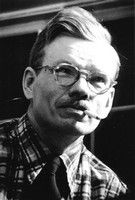Kenneth Stubbs |
 |
|
Stubbs Exhibit Shows Mastery of CompositionIn 1931, Kenneth Stubbs, a 24-year-old Georgia native and budding painter, took his first art classes with E. Ambrose Webster in Provincetown. Webster was a keen advocate of cubism, and by the time Stubbs took his second term at Webster School of Art three years later, his call to arms was set as he diligently applied himself to a friendly style of cubism up until his 1967 death. The "Kenneth Stubbs" exhibit at Provincetown Art Association and Museum runs only a few more days, but is worth catching as the kind of show PAAM excels at: showcasing an American modernist with ties to Provincetown who further burnishes its legacy as a landmark art colony. While Stubbs eventually settled in the Washington, D.C., area, his life is bookended by time in Provincetown, and he spent enough summers there to qualify as a worthy recipient of PAAM's attention. While the exhibition is not exclusively related to Provincetown, that is still the fulcrum upon which this show rests. With its wharves and pitched roofs and steeples tucked close to the shore, Provincetown was perfect fodder for Stubbs' ruminations on structural integrity and vitality. He was acutely involved with proportion based on the Golden Section, an ancient mathematical formula of perfect proportion that 15th-century Italian masters appropriated. Your eye can drop in from any corner of a Stubbs painting and it will happily make its way around every part of the canvas, so well-considered is the work. Many paintings here are quiet masterpieces in structure and composition and even in the earliest work, it's evident he had talent to spare. The exhibition begins with "Grace Powell" (1935), an atypical portrait sensitively painted but with a commanding dignity and graceful robustness that tips its hat to Diego Rivera. With a lovely vertiginous view of Provincetown and the bay behind the subject, there's nothing remotely cubist about the painting but it's still strong and thoughtful. The chronology moves through still lifes bearing traces of Cezanne before Stubbs' eventual commitment to the cubist idiom of flattening and fragmenting form to encompass multiple views becomes manifest. He loved Georges Braque and Picasso, for sure, but his work is closer in temperament to another Spaniard and his personal favorite: Juan Gris. Stubbs' work has a sunnier, less European, disposition. Paintings like "The Dancer" (1948) and "Swinging" (1957), with their unbridled joy and broad whoops of color, whip up a kinetic synergy that propels you in and around the picture plane. The colors are clear and crisp, with people, places and things ensnared within cross hairs of bisecting lines and colored planes. Everything here is treated equally so that the sum of its parts may encompass a unified whole. Stubbs achieves that unity partly through his skills as a colorist capable of elevating the humdrum with a piquant yellow that can punctuate and activate a painting's underlying rhythm. Deep plummy reds or a subdued umber, the colors may be flat but they're never inert. And as you follow Stubbs' work through point and counterpoint, its thoughtful precision amounts to an incisive lesson on how to put a painting together. Stubbs' reputation may not harbor the rhetorical bluster of some of Provincetown's more famous proponents, but based on this exhibition, the work's rigorous and undeniable quality convinces that he was easily on a par with the best of his contemporaries. Andre Van Der Wende, Cape Cod Times, November 17, 2011
|
See also: Show Announcement Catalog Provincetown Banner Review Art Knowlege News Announcement Works Shown Installation Photos |